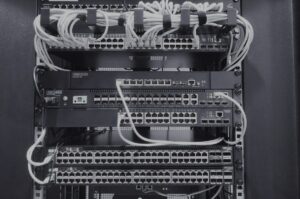For years, networking has been an exercise in frustration. Vendors provided and sold their hardware with proprietary software included. This forced companies to purchase more and more equipment from a specific vendor, which tied the two organizations ever closer together. It was a vicious circle with no sign of resolution.
However, a fairly new trend known as open networking is shaking these long hallowed foundations. Companies like Cisco and Lucent no longer have total control of the market with many other companies coming to the forefront.
The Growth of the Traditional Network
A network can be defined as a medium of communication between various devices. Networks range from the tiny, a simple home network, to the massive with office connections spanning the globe. The internet itself is simply a network of networks allowing communications to flow almost instantly around the world. The demand for data continues to grow with current predictions of 175 zettabytes by 2025. This is an increase of close to 60%. With the bulk of this data being stored in the cloud, data centers are expected to expand their services considerably.
Traditionally, networking equipment from a single vendor was the only option. Traditional networking uses proprietary software to connect switching and routing hardware. These networks are aging and businesses are looking at various options. At one time there were many pluses going with a single provider; however, companies have recognized that there are also many drawbacks. With the expected growth in the market over the coming years, alternative options needed to be considered.
The networking industry resembles the PC industry of several decades ago. At that time, companies like Apple and IBM were the only options available. Companies were forced to pick from a small pool of options with software choices being even more restrictive. As companies like Dell and others came onto the scene, the situation changed.
What is Open Networking?
With open networking companies are able to mix various hardware devices seamlessly. They are not restricted to a specific vendor and their proprietary software. With the growth in predicted data traffic, solutions like open networking are essential.
Over time, networks have grown ever more complex. Network changes and upgrades have far reaching impacts due to the interconnection of endpoints. Security alone is a massive hurdle that businesses need to overcome.
Open networking, with its use of Linux software as a core, offers many options to organizations. While their overall capabilities are not as powerful (yet) as some of the established traditional providers, this is changing rapidly.
The Positives of Traditional Networks Over Open Networks
Traditional networks do have some positives to their credit. Despite the increased costs in proprietary software, the level of interconnectedness is high. This standardization of hardware and software ensures that support is simpler. When switches, routers and firewalls all use the same commands and language, they are easier to troubleshoot.
Another significant positive is the training available to network administrators on maintenance and configuration. Traditional hardware vendors have comprehensive training programs and certifications. These programs provide network engineers with an exceptional level of knowledge and skill. With IT staff changing in businesses all of the time, having a base level of knowledge to call upon is a useful skill.
How Open Networking is Winning Over Traditional Networks
Open networks based on Linux are generally more flexible than traditional hardware based networks. Using open networks helps the developers in programming the network directly. However, in a traditional network, specific standard protocols need to be followed.
The pace of change with technology and the use of data is only increasing. New applications like IoT (Internet of Things), mobile usage and big data are only adding more pressure. Traffic demands require ever more bandwidth. The cost of building an open network is much lower than that of a traditional network. Moreover, open networking provides better business scaling along with higher productivity.
From a cost point of view, open networks are considerably more cost effective as they can be configured on disparate hardware. While Cisco and Lucent are industry names in the networking field, open networking has some well-known names also with Dell and HP. Others like Accton, Edgecore and Quanta are not yet household names, but they are helping drive significant growth.
Industry stats show significant savings on space, power and overall cost of open networking projects in comparison to traditional deployments. Rack utilization and power usage are both significant at above 50%.
Open networks are designed for today’s needs. Traditional networks grew over time and many of the use cases they were designed for no longer exist. This adds extra complexity into an already complex product. On the flip side, traditional networks have been exposed to scenarios that open networks are only being introduced to. Core switches, for example, are still beyond the capabilities of open networks.
Comparing Open Networks and Traditional Networks
Over the past four decades, technological advancement and change has been tremendous. Early networks helped build this new world. However, they are complex and less than efficient. Increasing IT budgets alone will not enable a sufficiently speedy pace of change and the burden on IT is only growing.
Traditional proprietary hardware vendors maintain a vertical black box approach. Hardware and software is joined closely together in terms of functionality and performance. Negatively, this keeps customers locked in. With long term support agreements, the cost of maintenance can sometimes exceed the original purchase price.
Open networks, by contrast, are software based networks. The physical hardware is not as important to the services being provided. In the server space the introduction of Linux and virtualization broke a long standing monopoly. The traditional black box networking stack is the problem open networking is perfectly placed to solve. By removing the links between hardware and software, consumers have more choice and flexibility.




